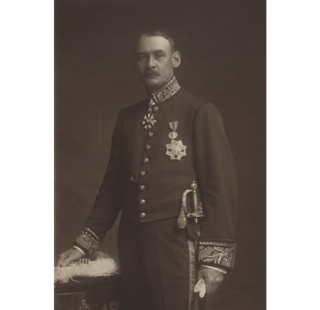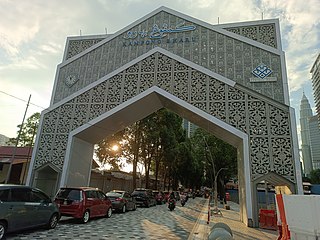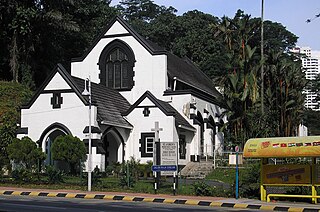
Kuala Lumpur, officially the Federal Territory of Kuala Lumpur and colloquially referred to as KL, is a federal territory and the capital city of Malaysia. It is the largest city in the country, covering an area of 243 km2 (94 sq mi) with a census population of 2,075,600 as of 2024. Greater Kuala Lumpur, also known as the Klang Valley, is an urban agglomeration of 8.8 million people as of 2024. It is among the fastest growing metropolitan regions in Southeast Asia, both in population and economic development.

The Federated Malay States was a federation of four protected states in the Malay Peninsula — Selangor, Perak, Negeri Sembilan and Pahang — established in 1895 by the British government, and which lasted until 1946. In that year they formed the Malayan Union together with two of the former Straits Settlements,, and the Unfederated Malay States. Two years later, the union became the Federation of Malaya, which achieved independence in 1957, and finally Malaysia in 1963 with the inclusion of North Borneo, Sarawak and Singapore.

Bangsar is a residential suburb on the outskirts of Kuala Lumpur, lying about 4 kilometres (2.5 mi) south-west of the city centre. It is part of the Lembah Pantai parliamentary constituency. Bangsar is administered by Dewan Bandaraya Kuala Lumpur (DBKL), unlike other townships in the Klang Valley such as Petaling Jaya and Subang Jaya which have their municipal councils. Neighbourhood residents' associations and business councils play a part in communicating with the local authority, but they exercise no legal or administrative power. Malays make up most of the population at 61%, followed by the Chinese at 24%, Indians at 15%.

Klang or Kelang, officially Royal City of Klang, is a city, royal city and former capital of the state of Selangor, Malaysia. It is located within the Klang District. It was the civil capital of Selangor in an earlier era prior to the emergence of Kuala Lumpur and the current capital, Shah Alam. Port of Port Klang, which is located in the Klang District, is the 12th busiest transshipment port and the 12th busiest container port in the world.

The Sultan Abdul Samad Building is a late-19th century building located along Jalan Raja in front of Dataran Merdeka and the Royal Selangor Club in Kuala Lumpur, Malaysia. The building originally housed the offices of the British colonial administration, and was known simply as Government Offices in its early years. In 1974, it was renamed after Sultan Abdul Samad, the reigning sultan of Selangor at the time when construction began.

Independence Square is a square located in Kuala Lumpur, Malaysia. It is situated in front of the Sultan Abdul Samad Building. It was formerly known as the Selangor Club Padang, or simply the Padang, and was used as the cricket green of the Selangor Club. It was here that the Union Flag was lowered and the Malaysian flag hoisted for the first time at midnight on 31 August 1957. Since then, the Independence Square has been the usual venue for the annual Independence Day Parade.

The National Museum is a public museum in Kuala Lumpur, Malaysia dedicated to Malaysian art, culture, and history. Located on Jalan Damansara close to Perdana Lake Gardens across KL Sentral station. Its façade comprises elements from both traditional Malay and modern features. It was inaugurated on 31 August 1963, and it serves as a repository of Malaysia's cultural and historical heritage.

Sir Edward Lewis Brockman was a colonial administrator who served briefly as the Colonial Secretary to the Straits Settlements in 1911 and was the chief secretary to the Federated Malay States (FMS) from 1911 to 1920. He announced the establishment of the Town Planning Committee to oversee Kuala Lumpur town planning service. He was descendant of the English Brockman family. Brockman Road in Kuala Lumpur was named after him, where the former Prime Minister office was located.

Ampang, or Ampang Hilir, is a ward and city district, in the eastern part of Kuala Lumpur (KL) in the Titiwangsa constituency. Its area in Kuala Lumpur can be identified as being along the Ampang Road and Ampang Hilir.

Kampung Baru or Kampong Bharu is a Malay enclave in central Kuala Lumpur, Malaysia. One of the most valuable tracts of land in the capital, it has been estimated to be worth up to US$1.4 billion.

The People's Plaza is an under construction mixed-use skyscraper complex in Kuala Lumpur, Malaysia initiated during the 1990s. However the project, which had already commenced construction, stalled due to the 1997 Asian financial crisis until 2020 and is currently revived by DBKL.
The architecture of Kuala Lumpur is a blend of old colonial influences, Asian traditions, Malay Islamic inspirations, modern and post modern mix. Being a relatively young city, most of Kuala Lumpur's colonial buildings were built toward the end of 19th and early 20th century. These buildings have Mughal, Tudor, Neo-Gothic or Grecian-Spanish style or architecture. Most of the styling have been modified to cater to use local resources and the acclimatized to the local climate, which is hot and humid all year around.

The Royal Malaysia Police Museum is a museum that showcases the history of the Royal Malaysia Police, located in Kuala Lumpur, Malaysia. The museum includes exhibits from the history of the Royal Malaysia Police since its origins under British colonial rule until the 1970s. It is open daily, except Monday, from 1000 to 1800 hours, and admission is free.

KL Eco City, or KLEC for short, is a 25-acre integrated mixed-use development project in the city of Kuala Lumpur, Malaysia. The project is built at the site of former Haji Abdullah Hukum Village. The mixed development project is helmed by S P Setia Berhad under a joint-venture agreement with the Kuala Lumpur City Hall (DBKL). It is built in stages comprising 3 residential towers, one serviced apartment tower, 3 corporate office towers, 12 boutique office blocks and a retail mall.

Arthur Benison Hubback was British Army officer and architect who designed several important buildings in British Malaya, in both Indo-Saracenic architecture and European "Wrenaissance" styles. Major works credited to him include Kuala Lumpur railway station, Ubudiah Mosque, Jamek Mosque, National Textile Museum, Panggung Bandaraya DBKL, Ipoh railway station, and Kowloon railway station.
BEP Akitek Sdn Bhd is an architectural firm based in Malaysia. Ralph Booty & Sidney James set up their practice in Singapore in 1910 and began the Booty Edwards & Partners firm on September 7, 1923. Ralph Booty had previously operated the firm Ralph Booty and Co. The new firm was first called Booty and Edwards.Arthur Oakley Coltman bought the firm in 1930. It was later called Booty, Edwards & Partners and the firm operated with offices in Colombo, Penang as well as Kuala Lumpur. In 1969 the firm was renamed BEP Akitek Sdn Bhd, the name it still carries. A major event in the firm's early history is when it won an architectural competition for the design of Colombo’s Town Hall and Municipal Offices, held in 1922. The Town Hall remains an imposing landmark in Colombo city. On May 24, 1924, the foundation stone was laid to build this magnificent building to house the Municipal Council of the country's principal city.
The following is an alphabetical list of articles related to Selangor.

Loke Chow Kit was a Malayan business magnate and philanthropist, who founded the first department store in Kuala Lumpur.

St Andrew's Church is a Presbyterian church situated in Jalan Raja Chulan, Kuala Lumpur, Malaysia.

The Former Supreme Court Building is the former court house of the Supreme Court of the Federated Malay States in Kuala Lumpur, Malaysia. It was opened in 1915 when the Supreme Court was relocated from Court Hill.


















